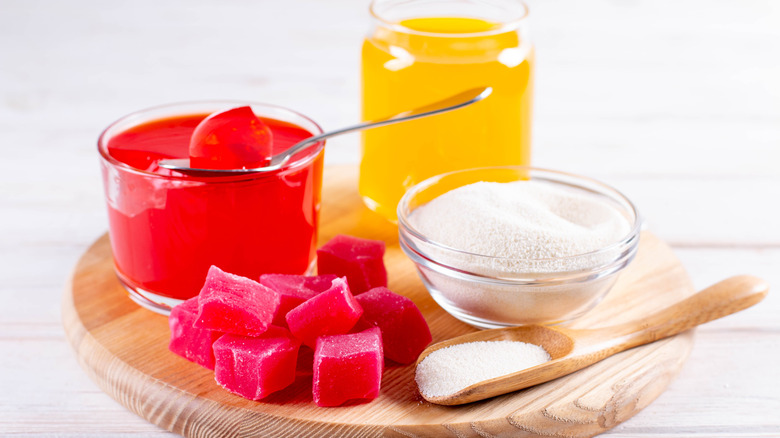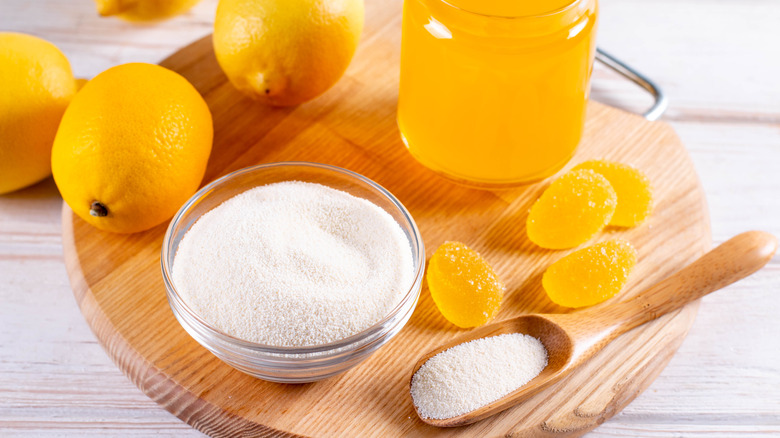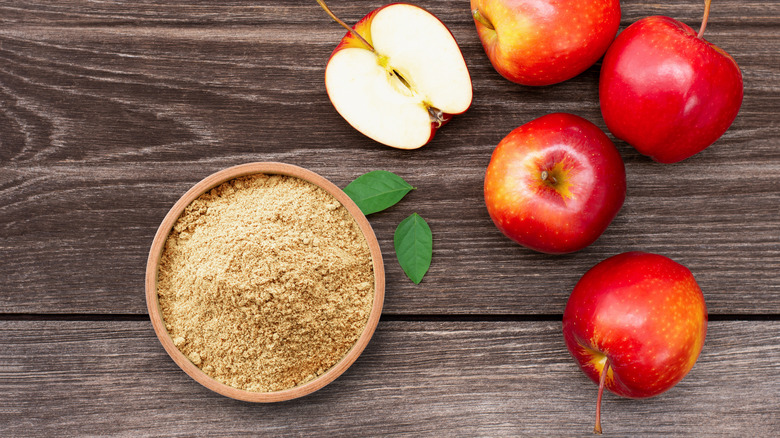For Making Easy Vegan Gelatin, Look No Further Than Pectin
If you like to spread jam on your toast or tear open a pack of fruit snacks every so often, chances are you're eating pectin on a regular basis. This useful substance is a fiber naturally found in fruit seeds, peels, and cores, and it's commonly used to thicken liquids, such as in homemade jam or jelly recipes. In stores, pectin is usually sold in the form of a powder or liquid. One of the best things about it, as you might guess, is that it's completely plant-derived, making it a great gelatin substitute for vegetarian- and vegan-friendly foods.
Gelatin is a go-to ingredient for thickening foods from panna cotta to no-bake cheesecake and Jello pudding, but it's sourced from animal bones and skin, making it unsuitable for anyone following a plant-based diet. Luckily, pectin functions in a similar manner, so vegans can enjoy alternative versions of their favorite recipes. The catch is that it's not always an easy swap.
You'll need to pay attention to the directions on your package of powdered or liquid pectin to ensure it will work with your recipe. You might need to seek out gelatin-based recipes that provide directions on how to use pectin instead, or simply experiment with trial and error. We do have a few tips that can help you use pectin successfully, and good results start with understanding how it differs from gelatin.
Pectin works a little differently than gelatin
To successfully use pectin, make sure that your recipe calls for enough sugar. Gelatin can be dissolved in water alone, but pectin requires the right amount of sugar and acid to activate its gelling properties. This is why homemade jam often needs lemon juice, in addition to sugar. If you're having a hard time getting your pectin to thicken or gel, adding a little extra sugar can improve the texture to your desired effect. While gelatin sheets may help make juicy meatballs, pectin won't work for more savory applications that don't use enough of the sweet stuff.
Pectin also needs heat to in order to thicken foods. Gelatin can activate and set at cooler temperatures, but pectin must be cooked to around 220 degrees Fahrenheit. Then, as it cools to room temperature, it will set up and thicken to the right texture. Just be careful to keep your pectin-based confections cool until you're ready to serve them. Pectin can break down into a liquid mess if it's heated up after it sets.
Pectin and gelatin also have slightly different textures after they're set. While gelatin is used for "bouncy," chewy, and stretchy foods, like marshmallows and fruit gummies, pectin will yield foods that are a little more firm and solid, but still chewy. On the bright side, both gelatin and pectin are flavorless, and allow the taste of other ingredients to shine.
You can make pectin from fruit at home
If you're unfamiliar with pectin, it may be a little daunting trying to swap it in for gelatin. Unfortunately, there's no popular, widely-tested, agreed-upon ratio for how much pectin to use in place of gelatin, whether in powdered or liquid form. You'll have to experiment a bit in order to adapt your favorite gelatin-based recipes, but if you remember what pectin requires in order to work properly, you'll be halfway to success.
Additionally, you can purchase pectin from most grocery stores, but some vegans and vegetarians (and other eaters) prefer to have full control over what goes into their food. If you'd prefer to make your own pectin, all you'll need is a little fruit, water, and acid. Apple peels and cores in particular contain high amounts of pectin. Boil unpeeled, cut-up apples in water and lemon juice for at least 40 minutes, strain the solids out, reduce it by boiling it thoroughly, and refrigerate it. This will leave you with liquid pectin that you can use in your recipes.
If you find that pectin simply isn't working for you, there are a few other vegan-friendly alternatives to gelatin. Sea moss gel is a gelatin substitute made from red algae, and agar-agar is a popular choice also derived from seaweed. Both can work as substitutes to create gelatin-free foods that are chewy and jelly-like in texture.


